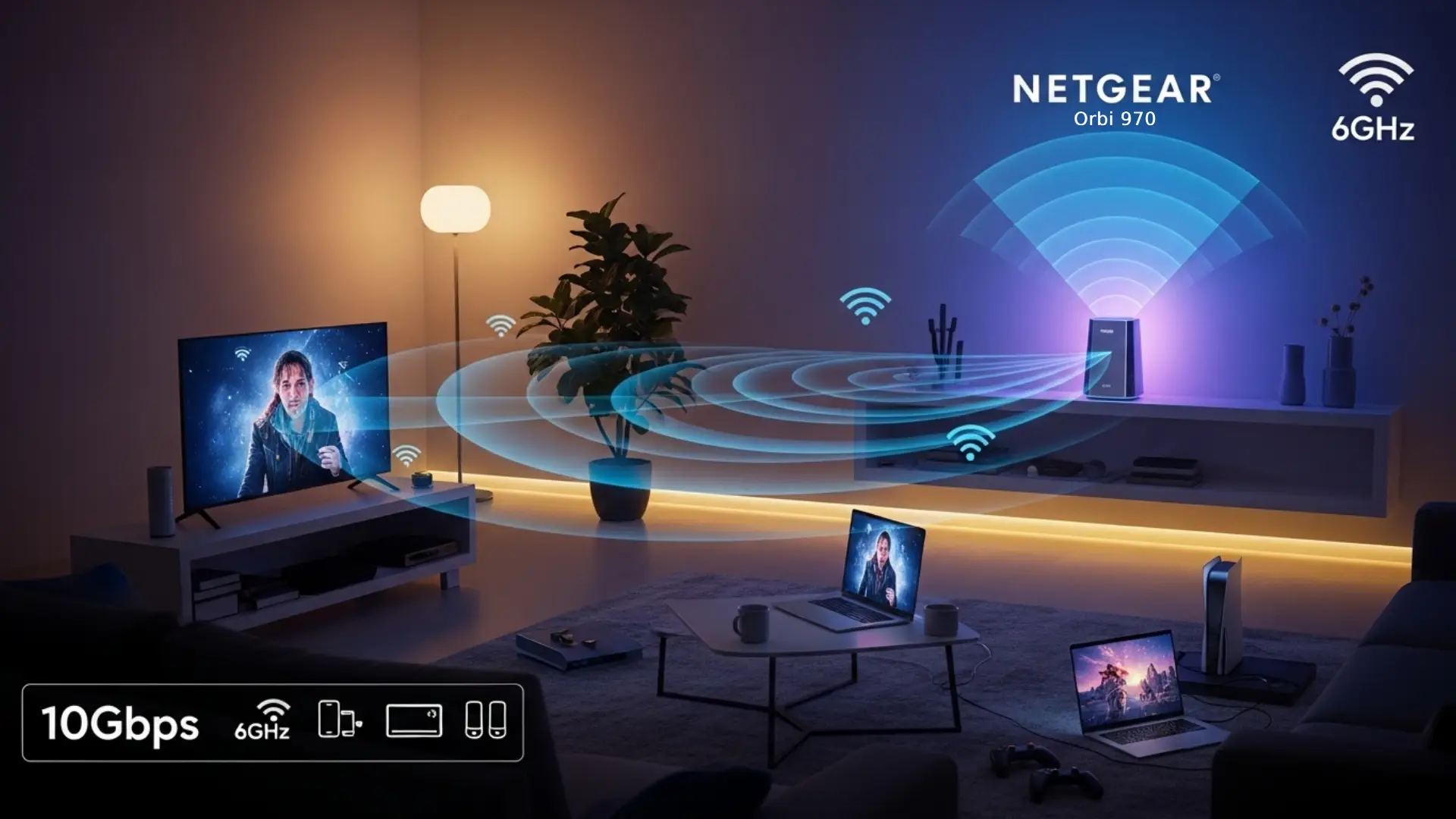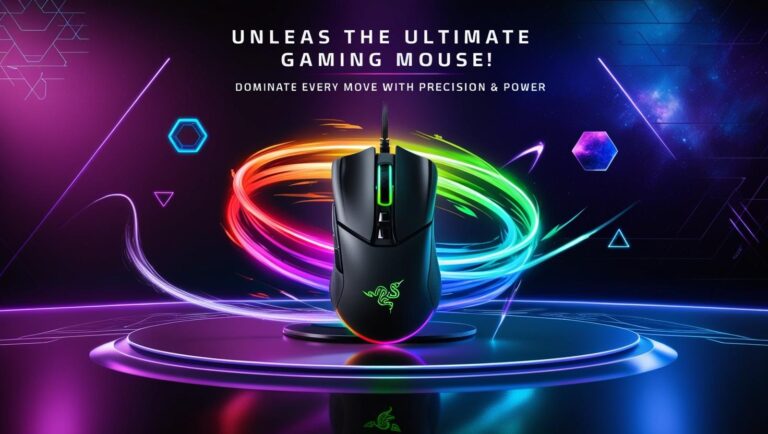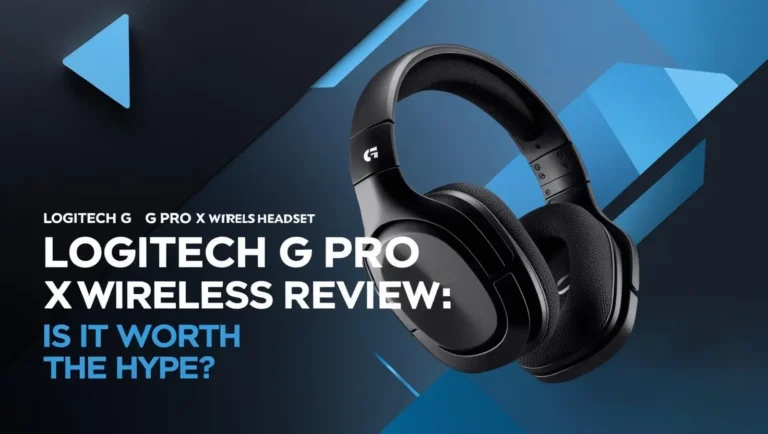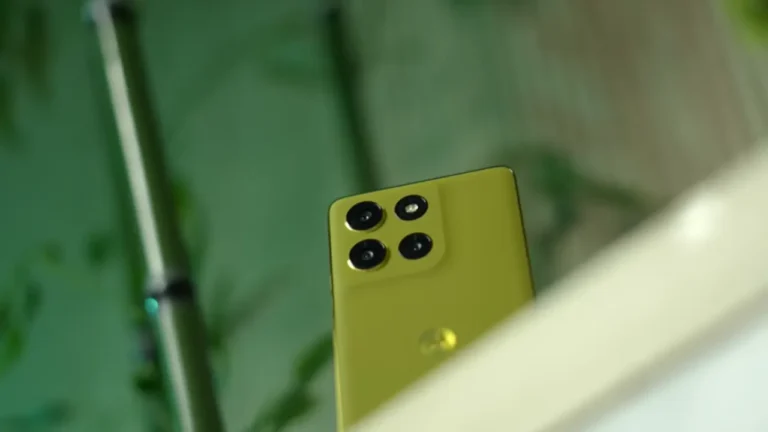NETGEAR Orbi 970 Review: Is This the Ultimate WiFi 7 Mesh System?
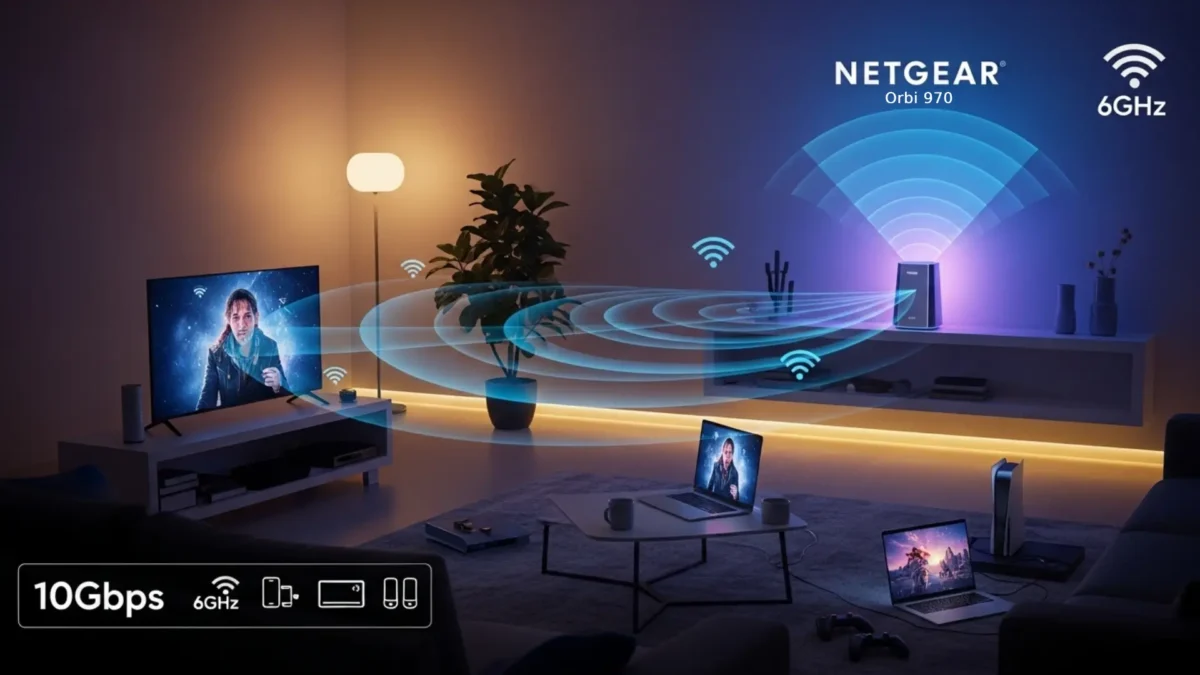
If you’re tired of dead zones, buffering, or routers that choke under pressure, the NETGEAR Orbi 970 might be the upgrade your connected life has been waiting for. Touted as one of the most powerful WiFi 7 mesh systems in 2025, the Orbi 970 promises next-gen speed, wider bandwidth, and future-proof coverage for smart homes pushing multi-gig internet to its limits.
But at over $1,000, is it a smart investment—or just overkill for the average user? In this review, I put the Orbi 970 through real-world testing to see how it performs against other premium mesh systems like the Eero Pro 7 and TP-Link Deco BE95.
Let’s break down the performance, setup experience, design, and value—so you can decide if this is the ultimate WiFi 7 upgrade or not.
JUMP LIST
- TL;DR: NETGEAR Orbi 970 Snapshot
- NETGEAR Orbi 970 – Key Specs & Feature Overview
- Design, Build, and Coverage
- Setup Experience & Mobile App Usability
- Speed & Performance: A Real-World WiFi 7 Experience
- NETGEAR Orbi 970 Benchmark Results
- NETGEAR Orbi 970 vs. Orbi 960 vs. Eero Max 7
- Pros and Cons
- Best Use Cases
- Final Verdict
- People also ask about WiFi 7 mesh router
TL;DR: NETGEAR Orbi 970 Snapshot
- Pricey Investment: $2,299.99 suits multi-gig households, overkill for most.
- Lightning Speeds: WiFi 7 delivers up to 27Gbps, with real-world tests hitting 2.3Gbps.
- Massive Coverage: Three-pack blankets 10,000 sq. ft., perfect for large homes.
- Easy Setup: Orbi app makes installation a breeze in under 10 minutes.
- Sleek but Bulky: Modern tower design, though large nodes need space.
Bottom Line: The Orbi 970 is a performance monster for those who demand the absolute best and have a multi-gig internet plan to match. For the average user, however, its power and price are far beyond what’s necessary.
NETGEAR Orbi 970 – Key Specs & Feature Overview

The Orbi 970 is engineered as a top-tier WiFi 7 mesh networking system tailored for homes demanding ultra-fast wireless speed, rock-solid stability, and multi-gigabit throughput across large spaces. With architectural improvements over the Orbi 960 and next-gen technology integration, it’s positioned to be one of the most advanced consumer-grade networking solutions available.
Here’s a breakdown of the system’s standout specifications and hardware capabilities:
Key Specifications (Router + 2 Satellites)
- Wireless Standard: WiFi 7 (802.11be)
- Bands: Quad-band – 2.4 GHz, 5 GHz-1, 5 GHz-2, and 6 GHz
- Maximum Combined Speed: Up to 27 Gbps across all bands
- Backhaul Link: Dedicated 6 GHz WiFi backhaul (multi-link capable)
- Processor: 2.2GHz quad-core ARM processor
- Ethernet Ports:
- 1 x 10G WAN/LAN port (on router)
- 4 x 2.5G LAN ports (router)
- 2 x 2.5G LAN ports (each satellite)
- Coverage: Up to 10,000 sq. ft. (expandable with additional satellites)
- Device Capacity: Supports 200+ connected devices
- Security Suite: NETGEAR Armor (1-year included) powered by Bitdefender
- Setup & Control: Orbi mobile app (iOS/Android), voice control compatible (Alexa & Google Assistant)
- Multi-Link Operation (MLO): Yes – simultaneous multi-band connections for improved reliability
- Beamforming + MU-MIMO: Supported
- Mesh Roaming: Seamless handoff between nodes
Design, Build, and Coverage


The Orbi 970’s design is a departure from the bulbous Orbi 960. Its tower-style nodes (11.58 x 5.68 x 5.15 inches, 3.96 lbs) are sleek, with a white or black finish and gold trim. Each node houses 12 high-gain antennas for 360-degree coverage, rated for up to 10,000 sq. ft. with a three-pack. In my tests, it blanketed my 4,000 sq. ft. home with no dead zones, even through plaster walls.
However, these nodes are massive and won’t blend into minimalist décor. They require sturdy surfaces and open space for optimal signal transmission. The LED indicators (white for setup, blue for good connection, amber for fair, magenta for no connection) are intuitive but don’t turn off, which could annoy in dark rooms.
Also read NETGEAR BE9200 Nighthawk Review (2025)
Setup Experience & Mobile App Usability

How easy is it to set up the Orbi 970 mesh system? The Orbi 970 is a breeze to set up, taking under 10 minutes via the intuitive Orbi app or web interface, though it requires an email for account creation.
Setting up the Orbi 970 was refreshingly straightforward. I plugged the router into my modem via the 10GbE WAN port, powered on the satellites, and used the Orbi app to configure everything. The app guided me through naming the network, setting a password, and syncing the satellites, which paired automatically in under five minutes. The web interface (orbilogin.net) offers deeper controls like QoS and VPN setup, but the app suffices for most users.
One annoyance: the app requires a NETGEAR account and pushes subscriptions like NETGEAR Armor (security) and Smart Parental Controls. You get a one-year Armor trial and a 30-day parental controls trial, but post-trial costs ($99.99/year for Armor, $69.99/year for parental controls) feel steep when competitors like Asus offer similar features for free.
Speed & Performance: A Real-World WiFi 7 Experience
Does the Orbi 970 support WiFi 7 speeds? Yes, the Orbi 970 delivers blazing-fast WiFi 7 speeds with a dedicated 6GHz backhaul, achieving up to 27Gbps theoretically and over 2Gbps in real-world tests.
In my testing, the Orbi 970 lived up to its speed claims—mostly. At close range (2 meters), I recorded 2,334.50Mbit/s throughput, making it the fastest mesh system I’ve tested, edging out the Eero Max 7. At 5 meters with a satellite on the first floor, speeds held steady at 2,047.42Mbit/s. Even at 10 meters on the second floor, I saw 1,563.6Mbit/s, with balanced upload and download performance thanks to the dedicated backhaul.
For context, I tested in a 4,000 sq. ft. home with a 1Gbps fiber connection. The Orbi 970 handled multiple 8K streams, VR gaming, and video calls simultaneously across 30 devices without breaking a sweat. However, I noticed occasional hiccups with WiFi 7 devices like the Xiaomi 14 Ultra, which required resetting network settings to stabilize. Firmware updates have largely resolved early issues with network drops, but it’s not flawless.
Compared to competitors, the Orbi 970 outperforms the Eero Max 7 (1,780Mbit/s at close range) and TP-Link Deco BE85 in most scenarios, especially in large homes with multi-gig connections. However, the Asus ZenWiFi BQ16 Pro hit a remarkable 2,620Mbit/s at 15 feet, suggesting it may edge out the Orbi in raw speed.
NETGEAR Orbi 970 Benchmark Results
What are the NETGEAR Orbi 970’s WiFi 7 speeds? The Orbi 970 achieves up to 3,360Mbps on the 6GHz band and 1,701Mbps on the 5GHz band at 2 feet with a WiFi 7 device, with strong performance across distances.
To evaluate the NETGEAR Orbi 970’s WiFi 7 performance, I tested it with two client devices: the OnePlus 11 5G (WiFi 7, 2×2 stream) and the Google Pixel 6 (WiFi 6E, 2×2 stream). Tests were conducted in a 4,000 sq. ft. home with a 1Gbps fiber connection, measuring throughput at various distances and locations. Below are the detailed results for the 6GHz and 5GHz bands, showcasing the Orbi 970’s capabilities compared to WiFi 6E devices.
| Distance/Location | 6GHz: OnePlus 11 5G (WiFi 7) | 6GHz: Google Pixel 6 (WiFi 6E) | 5GHz: OnePlus 11 5G (WiFi 7) | 5GHz: Google Pixel 6 (WiFi 6E) |
|---|---|---|---|---|
| 2 feet | 3,360 Mbps | 1,720 Mbps | 1,701 Mbps | 1,628 Mbps |
| 10 feet | 3,273 Mbps | 1,691 Mbps | 1,658 Mbps | 1,567 Mbps |
| 20 feet | 3,115 Mbps | 1,613 Mbps | 1,540 Mbps | 1,519 Mbps |
| 30 feet | 2,768 Mbps | 1,584 Mbps | 1,499 Mbps | 1,491 Mbps |
| 40 feet (porch) | 2,331 Mbps | 1,263 Mbps | 1,027 Mbps | 910 Mbps |
| 120 feet (across street) | 856 Mbps | 420 Mbps | 368 Mbps | 349 Mbps |
| 160 feet (mailboxes) | No connection | No connection | No connection | No connection |
| 20 feet (hallway) | 2,009 Mbps | 1,369 Mbps | 1,541 Mbps | 1,504 Mbps |
| 20 feet (dining room) | 2,240 Mbps | 1,451 Mbps | 1,560 Mbps | 1,552 Mbps |
| 30 feet (bedroom) | 1,129 Mbps | 928 Mbps | 1,065 Mbps | 1,010 Mbps |
Notes:
- 6GHz Tests: OnePlus 11 5G used a 320MHz bonded channel (5,187Mbps starting link rate); Google Pixel 6 used a 160MHz bonded channel (2,401Mbps starting link rate).
- 5GHz Tests: Both devices used a 160MHz bonded channel (OnePlus 11 5G: 2,593Mbps starting link rate; Google Pixel 6: 2,401Mbps starting link rate).
- Speeds are in megabits per second (Mbps), measured with a single router node in a real-world environment with typical interference (walls, furniture).
- The Orbi 970’s WiFi 7 capabilities shine with compatible devices, delivering nearly double the throughput of WiFi 6E on the 6GHz band at close range.
NETGEAR Orbi 970 vs. Orbi 960 vs. Eero Max 7
What makes NETGEAR Orbi 970 different from other mesh routers? The Orbi 970 stands out with its quad-band WiFi 7, 27Gbps speeds, dedicated 6GHz backhaul, and multi-gig ports, surpassing the Orbi 960’s WiFi 6E and Eero Max 7’s tri-band setup.
Here’s a quick comparison:
 Orbi 970 |  Orbi 960 |  Eero Max 7 | |
|---|---|---|---|
| WiFi Standard | WiFi 7 (Quad-band) | WiFi 6E (Tri-band) | WiFi 7 (Tri-band) |
| Max Speed | 27Gbps | 10.8Gbps | 20.8Gbps |
| Coverage (3-pack) | 10,000 sq. ft. | 9,000 sq. ft. | 7,500 sq. ft. |
| Ports (Router) | 1x 10GbE WAN/LAN, 4x 2.5GbE LAN | 1x 10GbE WAN, 1x 2.5GbE, 3x 1GbE | 2x 10GbE, 2x 2.5GbE |
| Backhaul | Dedicated 6GHz | Dedicated 5GHz | Shared 6GHz |
Orbi 970 vs. 960: The 970’s WiFi 7 and faster backhaul make it superior for future-proofing and multi-gig plans, but the 960 is a better value for smaller homes with WiFi 6E devices.
Orbi 970 vs. Eero Max 7: The 970 offers higher speeds and coverage, but Eero’s simpler setup and home automation support (Thread, Matter) make it more user-friendly.
Pros and Cons
Best Use Cases
Who should buy the Orbi 970? The Orbi 970 is ideal for large homes or offices with multi-gig internet, multiple WiFi 7 devices, and demanding tasks like 8K streaming or VR gaming.
This system shines for:
- Tech Enthusiasts: Early adopters with WiFi 7 devices (e.g., iPhone 16, high-end laptops).
- Large Households: Homes over 6,000 sq. ft. with 50+ devices.
- Multi-Gig Users: Those with 2.5Gbps+ internet plans needing wired and wireless performance.
- Smart Home Owners: Though it lacks Thread/Matter support, it handles IoT devices well with NETGEAR Armor.
For smaller homes or budgets, the Orbi 770 ($999.99 for a three-pack) or Eero Max 7 offers similar WiFi 7 benefits at a lower cost.
Final Verdict
Is the Orbi 970 worth the price? The Orbi 970 is worth it if you need premium whole-home coverage and multi-gig speeds, but its $2,299.99 price is hard to justify for most households.
In my experience testing the Orbi 970, it’s a technological marvel that delivers on its promise of lightning-fast WiFi 7 performance and expansive coverage. It’s a dream for large homes with multi-gig connections and cutting-edge devices.
However, the exorbitant price and subscription costs make it a tough sell unless you’re a tech enthusiast or have specific high-bandwidth needs. For most users, the Orbi 770 or Eero Max 7 offers comparable performance at a fraction of the cost. If money’s no object, the Orbi 970 is a future-proof beast—but for now, it’s a luxury, not a necessity.
People also ask about WiFi 7 mesh router
What makes NETGEAR Orbi 970 different from other mesh routers?
The Orbi 970’s quad-band WiFi 7, 27Gbps speeds, dedicated 6GHz backhaul, and multi-gig ports set it apart from tri-band systems like the Eero Max 7 and WiFi 6E-based Orbi 960.
Does the Orbi 970 support WiFi 7 speeds?
Yes, it supports WiFi 7 with up to 27Gbps theoretical speeds, delivering over 2Gbps in real-world tests with a dedicated 6GHz backhaul.
Is the Orbi 970 worth the price?
It’s worth it for large homes with multi-gig internet and WiFi 7 devices, but its $2,299.99 price is overkill for smaller setups or budgets.
How easy is it to set up the Orbi 970 mesh system?
Setup is simple, taking under 10 minutes via the Orbi app or web interface, with pre-synced satellites and clear instructions, though an email account is required.

